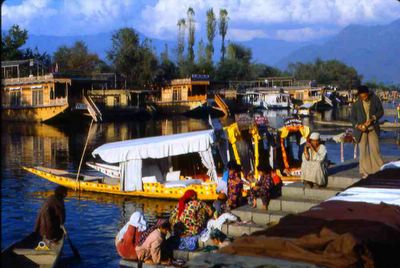
(Postscript right up front: Travel today, while bountifully rich in rewards, carries risks, and it’s wise to assess a destination’s security situation before visiting. This post describes a sojourn in an area of India considered by some governments to be, as of this date, unsafe for travel. Please see the end of this post for links to sources of information on travel safety, security and the threat of terrorism.)
We’d rented a houseboat, Mother India, which sat in Dal Lake in Srinagar, the contested and still strife-torn summer capital of northwest India's Himalayan department of Jammu and Kashmir. With a large Muslim population and history and culture shaped by centuries of Mogul rule, Srinagar is one of the pieces of real estate over which predominantly Hindu India and Muslim Pakistan continue to butt heads. Srinagar erupts periodically with clashes, many deadly, between Kashmir’s Muslim separatists and Indian government troops.
Things were peaceful when we visited, but we managed to create our own bit of intercultural friction.
It was chilly inside Mother India, but the furnishings were luxurious, and the whole place was finished in deep, patrician tones of gold and navy, rust and cinnamon, cream and hunter green. Brass fittings; mahogany paneling and furniture; lace and damask curtains; richly brocaded sofa and chairs; plush hand-loomed Asian carpets; elegant blood-orange flowers in a sparkling crystal vase.
And a houseboy.
I don’t do luxe very well – I have trouble getting past the waste and inequity of it – and Mother India’s interior – and certainly the young Muslim man assigned to cater to our whims – made me uncomfortable. But we’d spent other nights in India in seven-dollar hotel rooms that were little more than clammy concrete cells, so we rolled with it and decided to enjoy this floating mini-palace that looked like the Raj hadn’t ended and Queen Victoria was expected for tea.
We scoped out the kitchen. The refrigerator was empty, save for a big brown bottle of Indian beer. As our boat attendant was Muslim, we figured the beer was for us. A welcome present from the management, like chocolates on the pillow or chocolate chip cookies at the front desk. We grabbed the bottle and sat on the lime green and fuchsia upholstered banquette on Mother India’s front porch to watch life float by on Dal Lake, ringed by stark, snow-topped Himalayas and capped by a vivid blue snowglobe sky.
Only after the houseboy turned surly, stopped cleaning, and stopped hailing us shikara, the narrow, colorful, canopied water taxis that ply the lake, poled along by thin men with close-cropped beards, did we realize we’d drunk our Muslim friend’s beer. We should have asked rather than assumed.
Feeling badly, we knew we had to make amends, so we made our way down the gangway that connected Mother India to a string of other houseboats and waved our arms until a shikara made its way over and picked us up. Once deposited in Srinagar town, we roamed the warren of old streets lined with tall, ancient wooden houses, many with storefronts or workshops cut into their ground floors. We found a market and bought two big bottles of beer.
Back on Mother India, we put one bottle in the refrigerator as a gesture of international entente. Night was falling, and we took the other bottle out to the porch, settled into the lime-fuchsia banquette and put our feet up on the railing. We’d done what we could to assuage ill feelings, so there was nothing left but to kick back and enjoy the rest of our Srinagar stay. We clinked glasses and hoped the rest of the evening would be pleasant. There was still time for something nice to happen.
As we stared into the moonlit ripples playing in the water in front of us, we heard bagpipes. They grew louder, and suddenly an immense two-story barge appeared in the channel where our boat was moored. Crammed on both decks with loud revelers and lit with hundreds of rainbow-colored bulbs, the party barge was the venue for an Indian wedding, and the magnificent leviathan was ferrying the entire wedding complement to a lavish, oversized houseboat anchored not far from ours. The spectacular craft, which appeared like a vision, passed less than a hundred feet from where we sat. We could see detail on the women’s opulent silk saris and the broad, proud grin of the bride’s father, who stood at the bow on the top deck, shaking guests’ hands. People swayed to the stirring strains of the bagpipes, at once gorgeous and incongruent. Scottish Highlands sounds, vestiges of bygone colonialism, grace notes to a modern Indian marriage ceremony.
Just as the incredible wedding boat passed in front of Mother India, the celebrants shot fireworks into the Himalayan sky. The spent chutes of color and light floated downward. They created fleeting mirror images on Dal’s surface, then were joyously swallowed by the black lake.
---
*Conflict continues in Jammu and Kashmir and in Srinagar itself. As of the date of this post, March 1, 2005, the governments of both the United Kingdom and Australia were “strongly advising against all travel to Jammu and Kashmir, with the exceptions of Ladakh via Manali or air to Leh.” The region does not appear on today’s US State Department travel warnings list.
Travelers should check several trusted travel warning sources before visiting contested regions or countries and comparing US, UK and Australian government advice provides a broad view. It’s also helpful – and enlightening – to read online editions of newspapers from a country or region to gauge the local mood and situation. Where freedom of the press exists, you should be able to access several news sources, including independent, non-government outlets. Find links to world newspapers at www.World-Newspapers.com and www.OnlineNewspapers.com.
